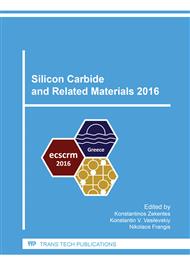p.642
p.649
p.655
p.661
p.665
p.669
p.673
p.677
p.681
Experimental Verification of a Self-Triggered Solid-State Circuit Breaker Based on a SiC BIFET
Abstract:
In this work, the feasibility of the Bipolar-Injection Field Effect-Transistor (BIFET) [5] in two different Dual Thyristor type circuits [4] for an application as solid-state circuit breaker (SSCB) is experimentally verified. The Dual Thyristor type circuits are assembled from discrete silicon JFETs and a silicon carbide BIFET and are electrically characterized at various temperatures. The current-voltage characteristic shows the expected regenerative self-triggered turn-off capability under over-currents and the option to control the turn-off current by a passive resistor network. The issue with the adverse positive temperature coefficient of the trigger-current can be solved by putting the SiC BIFET in a cascode arrangement with a silicon Dual Thyristor. In this configuration the SiC BIFET provides the high voltage blocking capability and the silicon Dual Thyristor with its negative temperature coefficient controls the trigger-current. Transient analyses of both circuits indicate fast switching times of less than 50 μs seconds. It is demonstrated for the first time, that the SiC BIFET, due to its normally-on behaviour, used in a Dual Thyristor type circuit is a promising concept for self-triggered fuses in high current and high voltage applications.
Info:
Periodical:
Pages:
665-668
Citation:
Online since:
May 2017
Price:
Сopyright:
© 2017 Trans Tech Publications Ltd. All Rights Reserved
Share:
Citation:


